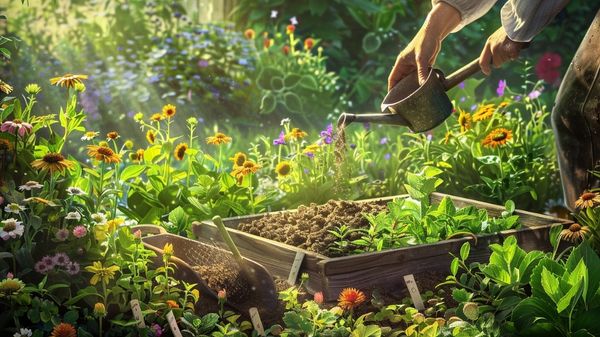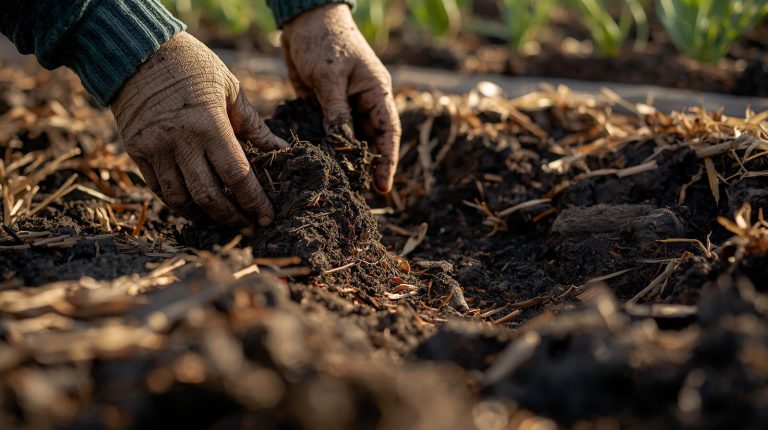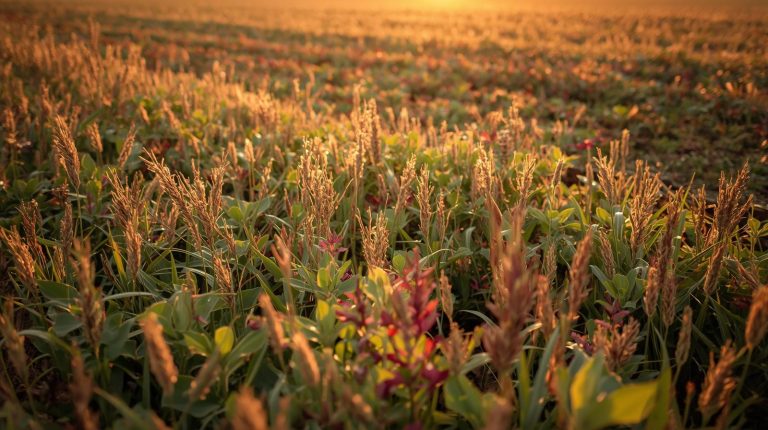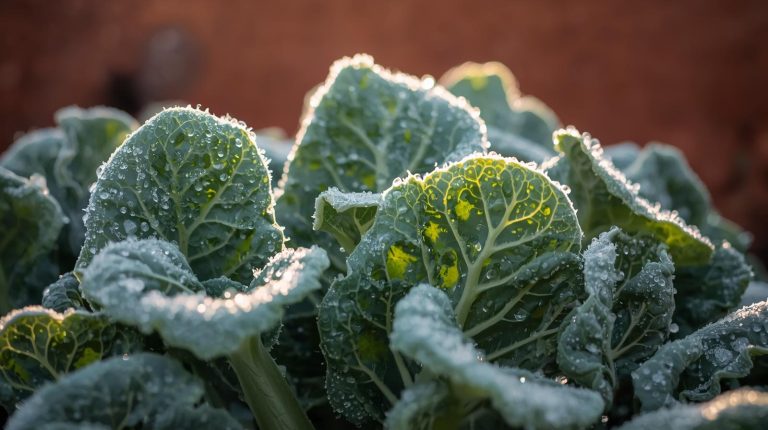To initiate your eco-friendly gardening journey, prioritize selecting native and drought-tolerant plants, such as Aloe Vera or Black-Eyed Susan, which require minimal maintenance. Employ efficient water practices by utilizing drip irrigation systems and watering early in the morning. Implement soil health strategies by adding organic compost and practicing crop rotation to sustain nutrient levels.
Promote biodiversity by creating habitats for beneficial insects and grouping plants with similar needs. Utilize mulch to enhance soil moisture retention while preventing root rot. By integrating these techniques effectively, you can guarantee a vibrant and sustainable garden that fosters ecological balance. Further insights await your exploration.
Select Eco-Friendly Plants
When you choose eco-friendly plants for your home, you’re investing in low-maintenance favorites that thrive with minimal effort. Among your best options are the Snake Plant and Golden Pothos, both known for their tolerance to low-light conditions and infrequent watering, making them perfect for busy lifestyles.
These plants not only enhance plant aesthetics through their striking foliage but also contribute to air purification, improving your indoor air quality. Healthy soil is essential for maintaining vibrant indoor plants as it promotes better growth and resilience.
For added variety, consider the drought-tolerant Aloe Vera or the easy-to-grow Rubber Plant. If you desire a lush look, the Boston Fern offers lush greenery while requiring medium indirect light and humidity. Low-light plants may still require some natural light to thrive, so be sure to place them near a window.
Each of these eco-friendly options demands less attention, allowing you to enjoy the benefits of nature without overwhelming maintenance. When selecting your plants, think about size and growth potential—options like the Bird’s Nest Fern or Money Tree add dimension to your space while still being manageable.
Be mindful of care specifics, like needing well-draining soil and rotating your plants for even growth. With the right choices, you’ll create a thriving indoor garden that reflects your values and brings joy to your home.
Implement Efficient Water Use
To promote a flourishing garden while conserving water, you can implement various efficient watering techniques.
Start by deep watering your plants infrequently; this encourages deep root growth and minimizes water evaporation. Watering in the early morning maximizes water uptake and reduces the risk of fungal diseases.
Consider using drip irrigation systems, which deliver water directly to plant roots, greatly enhancing irrigation efficiency by minimizing waste caused by evaporation and runoff. Additionally, watering at the soil line keeps leaves dry, further preventing water loss.
Enhancing your soil’s water retention is essential for water conservation. Incorporate organic matter, like compost, to improve soil structure and moisture-holding capacity. Annually adding compost maintains ideal soil conditions.
Apply a 2-3 inch layer of organic mulch to suppress weeds and retain moisture, while regularly testing your soil can reveal areas needing improvement. Utilizing moisture meters can also help ensure you’re providing the right amount of water for your plants. Consider investigating how greywater recycling systems can contribute to extensive water savings in your garden.
Moreover, consider implementing smart watering technologies such as timers and moisture sensors to automate and enhance your irrigation schedules effectively.
Regularly maintain your systems to avoid leaks, and adjust your watering practices seasonally to conserve as much water as possible, ensuring your garden remains vibrant and sustainable.
Create a Sustainable Ecosystem
How can you create a sustainable ecosystem in your garden that thrives naturally? To achieve an ecosystem balance, you need to take into account native plants and promote natural interactions among various organisms.
First, choose plants native to your region, as they require less water and create habitats for local pollinators. Native plants also play a vital role in carbon sequestration, significantly contributing to climate change mitigation.
Here are some essential strategies:
- Select diverse plant species to support biodiversity and attract beneficial insects. Native plants can be particularly effective, as they naturally resist local pests and require less watering compared to non-native species.
- Group plants with similar needs together to optimize resource allocation and care.
- Encourage pollinator habitats by incorporating flowers that draw in bees and other essential species.
- Design your garden to mimic natural ecosystems, observing local interactions to understand what works best.
Promote Soil Health
Building a sustainable ecosystem in your garden naturally leads to the significance of promoting soil health. Healthy soil is crucial for supporting plant life, enhancing microbial health, and fostering biodiversity.
Start by adding organic matter, such as compost, which not only improves soil structure but also boosts its water-holding capacity. Regularly test your soil to maintain ideal pH, ensuring conditions are favorable for both plants and beneficial microbes.
Implementing soil amendments, like cover crops and mulching, will protect your soil during the off-season, reduce compaction, and prevent erosion. As you incorporate cover crops, consider legumes or vetch, which enrich the soil with nitrogen and organic matter while helping to retain moisture.
Additionally, utilizing organic compost can significantly enhance your garden’s soil quality by promoting microbial activity. Minimizing disturbance through low-dig techniques preserves the soil food web, ultimately supporting a diverse range of microorganisms essential for nutrient cycling.
Choose Low-Maintenance Options
Choosing low-maintenance options for your garden can greatly ease your workload while still creating a vibrant ecosystem. By selecting low maintenance perennials and easy care shrubs, you not only simplify upkeep but also support local biodiversity.
Native and drought-tolerant plants are excellent choices, as they thrive in your local climate, requiring less water and care. This is particularly beneficial because drought-tolerant plants are designed to withstand dry conditions, making them ideal for busy schedules while enhancing the resilience of your garden.
Additionally, selecting these native species plays a role in ecosystem rebuilding and promoting environmental health. Consider incorporating these options:
- Columbine: A stunning native perennial that attracts pollinators.
- Black-Eyed Susan: Resilient and self-seeding, it adapts well to various soils.
- Lavender: Known for its fragrance, it thrives with minimal watering needs.
- Sedum: Perfect for rock gardens, this plant excels in poor soil conditions.
Adopt Organic Gardening Practices
Adopting organic gardening practices transforms your outdoor space into a flourishing and sustainable environment. By selecting untreated seeds and plants, you can avoid genetically modified organisms (GMOs) and hybrids that require chemical inputs, paving the way for a healthier garden ecosystem.
Opt for heirloom or open-pollinated varieties, guaranteeing biodiversity and sustainability in your planting choices.
Natural fertilization methods are vital; using homemade compost as a natural fertilizer enhances soil health without the detrimental effects of synthetic fertilizers. Combine compost with soil before planting and separate applications throughout the growing season to optimize nutrient availability.
Additionally, shun chemical pesticides, favoring natural pest control strategies such as handpicking pests or employing companion planting.
You might also encourage beneficial insects to maintain pest populations at bay. When necessary, choose organic pesticides crafted from natural ingredients.
It’s important to protect your garden from chemical contamination by constructing raised beds from untreated materials. This precautionary measure, paired with regular monitoring of soil health, guarantees your organic methods remain effective and your garden thrives, all while embracing practices like crop rotation to prevent nutrient depletion and pest infestations.
Furthermore, understanding specific plant needs will help you make informed decisions about watering and sunlight requirements for optimal growth.
Support Biodiversity
To support biodiversity in your garden, start by planting native species that thrive in your local climate, as these plants are well-adapted and require less maintenance. Drought-resistant plants such as Gulf Coast Muhly and Purple Coneflower can enhance the diversity of your garden.
Alongside a diverse selection of flowers, shrubs, and trees, encourage beneficial insects by integrating habitats such as bee hotels and butterfly feeders; this attracts these essential pollinators.
Additionally, implementing sustainable practices like composting can significantly improve soil health and foster a thriving ecosystem. Such practices not only enhance ecological balance but also contribute considerably to the overall health of your garden ecosystem.
Plant Native Species
Planting native species is one of the most effective ways to support biodiversity in your garden. By choosing plants that thrive in your local environment, you not only enhance plant diversity but also create habitats that support a variety of wildlife.
Native species have evolved over time, adapting to local conditions and forming intricate relationships with surrounding flora and fauna. Here are several benefits of incorporating native plants into your gardening efforts:
- They provide essential habitat and food for local wildlife, including birds and beneficial insects.
- Their deeper root systems improve soil health, reduce erosion, and support ecosystem services like water filtration.
- Native plants require less maintenance and water, making your gardening efforts less demanding.
- By fostering local wildlife populations, you contribute to ecological balance and mitigate the impacts of invasive species. Additionally, studies show that native plants support significantly more caterpillar species which are crucial food sources for many birds.
When you create a garden filled with native plants, you’re establishing a thriving ecosystem that benefits both you and the environment.
Embrace the beauty of your local ecology and watch as your garden flourishes in harmony with nature. By prioritizing native species, you’re creating a welcoming and resilient space that nurtures biodiversity for generations to come.
Encourage Beneficial Insects
Creating a garden that nurtures beneficial insects can considerably enhance biodiversity in your outdoor space. To achieve this, it’s important to provide diverse blooms throughout the season, ensuring a constant supply of nectar and pollen that attracts a variety of beneficial insects.
Incorporate native herbs and flowers, which naturally draw in these essential creatures, helping to control pests without harmful chemicals. Establish beneficial habitats by stacking wood and branches, creating refuge spaces that encourage insect habitation. Additionally, insects control pest populations, thereby benefiting your garden’s health.
Installing mason bee nests or wooden pollinator houses also promotes these populations. Minimizing harm is significant; avoid chemical pesticides that threaten beneficial insects and instead employ organic pest control methods, such as neem oil.
Insect identification plays a key role in your efforts, as recognizing species like ladybugs and lacewings aids in supporting their presence. Additionally, consider local plant selections that align with your garden’s specific conditions and insect populations.
Utilizing resources from organizations such as the National Wildlife Federation can provide invaluable insights in curating a rich, biodiverse garden that fosters an environment in which beneficial insects thrive.
Utilize Composting Techniques
Composting is an effective way for you to recycle organic waste, greatly benefiting your garden by improving soil health and reducing landfill contributions. To get started, gather appropriate kitchen scraps and brown materials, then select a composting technique that suits your lifestyle, whether it’s hot, cold, or tumbler composting. Composting not only enhances soil quality but also diverts yard waste from landfills, contributing to a more sustainable environment.
Benefits of Composting
When exploring eco-friendly gardening, you’ll discover that the benefits of composting are impressive and far-reaching. Composting not only enriches your garden soil with essential nutrients and beneficial microbes, but also creates a sustainable cycle that enhances your overall gardening experience.
By maintaining a proper nutrient balance in the soil, you’re likely to see healthier plants that resist pests and diseases more effectively. Here are some key benefits of composting:
- Reduction of greenhouse gas emissions: Diverting organic waste from landfills minimizes methane production.
- Enhanced soil structure: Compost improves aeration and moisture retention, leading to better growth.
- Economic efficiency: Using compost reduces your need for fertilizers and pesticides, lowering overall gardening costs.
- Environmental restoration: Composting contributes to reforestation and habitat revitalization, supporting biodiversity.
Embracing composting techniques won’t only benefit your garden but also contribute positively to the environment.
By incorporating compost into your ecosystem, you’re fostering a sustainable practice that nurtures both your plants and the planet.
Composting Materials to Use
Utilizing a variety of composting materials is essential to creating a nutrient-rich environment for your garden. When you gather materials, think about the composting benefits derived from both green and brown materials, ensuring a balanced mix. Greens, such as fruit and vegetable scraps, grass clippings, and coffee grounds, are rich in nitrogen, vital for microbial activity.
Conversely, browns like dry leaves, shredded paper, and straw supply carbon, which is equally important for maintaining proper material ratios. To achieve an effective compost pile, alternate layers of green and brown materials, ensuring a two-to-one ratio of browns to greens. This consistently optimizes the carbon-nitrogen balance, necessary for efficient decomposition.
Avoid adding problematic materials such as meat, dairy, and pet waste, as they can attract pests and introduce pathogens. Additionally, remember to chop or shred larger items to expedite decomposition, maintain moisture levels similar to a damp sponge, and mix in twigs or straw to enhance air circulation within your compost.
Following these guidelines will foster a thriving compost system, ultimately enriching your garden soil and reinforcing a sense of community through shared eco-friendly practices.
Composting Techniques for Beginners
Creating a successful compost pile is only the beginning; knowing the right techniques can make all the difference in transforming organic waste into nutrient-rich soil. By choosing the appropriate composting method—either traditional composting in your yard or creating worm bins for indoor spaces—you’ll set yourself on the right path.
To maintain an effective compost pile, consider the following:
- Start with a base layer using twigs or mulch for drainage.
- Alternate green materials, like kitchen scraps, with brown materials, such as dry leaves.
- Regularly turn the compost every week or two to aerate it and speed up decomposition.
- Monitor moisture levels, aiming for a sponge-like dampness throughout the pile.
It’s essential to be aware of compost troubleshooting techniques; if unpleasant odors arise, balance your green and brown materials. Optimize your conditions by finding a partially sunny spot with good drainage, ensuring easy access from your kitchen.
Ultimately, whether you choose traditional methods or worm bins, understanding these composting techniques won’t only foster community involvement in eco-friendly practices but will also nurture your garden with rich, organic soil.
Incorporate Native Plants
Incorporating native plants into your garden not only enhances its beauty but also promotes a sustainable environment. By choosing local species, you directly contribute to the native species benefits that enrich your garden.
These plants adapt effortlessly to local soil and climatic conditions, which means they require less water and maintenance, ultimately lowering your water bills and conserving a precious resource. Their deep root systems greatly improve soil structure, allowing water to penetrate more effectively and reducing runoff.
Additionally, native plants play an essential role in reducing chemical use; they draw fewer pests and diseases, minimizing the need for fertilizers and pesticides, thereby protecting local ecosystems. For gardeners seeking expert guidance and access to region-specific species, resources like Direct Native Plants can offer a wide selection of native varieties cultivated to thrive in diverse local conditions.
When you cultivate these plants, you’ll also support biodiversity by providing essential habitats for pollinators and local wildlife, which is crucial for maintaining the delicate balance within the ecosystem.
Ultimately, embracing native plants fosters a sense of belonging to your local community, as you not only enhance your own garden but also contribute positively to the local ecosystem impact.
Practice Mulching Techniques
One of the simplest yet most effective ways to enhance your garden’s health is by practicing proper mulching techniques. By choosing the right mulch types, you reveal numerous mulching benefits that greatly contribute to your garden’s vitality.
Begin by selecting organic options, which not only decompose but also enrich the soil with essential nutrients. Here are some mulch types to reflect upon:
- Straw: Excellent for vegetable gardens, it conserves moisture and suppresses weeds.
- Leaf Litter: A sustainable choice, it protects garden beds while recycling fall leaves.
- Cocoa Bean Shells: Nutrient-rich, they break down well and improve soil fertility.
- Pea Gravel: Ideal for well-drained landscapes, suitable for rock gardens.
To maximize the advantages, apply a 2-4 inch layer of mulch around your plants once you’ve prepared the area by clearing weeds and debris.
Remember to prevent over-mulching, which traps moisture and can cause root rot. Refresh the mulch as it decomposes to maintain its benefits throughout the growing season.
Emphasizing sustainable practices, you not only bolster your garden but also contribute positively to the environment.
Frequently Asked Questions
How Can I Attract Pollinators to My Garden?
To attract pollinators to your garden, prioritize native plants, as they’re tailored to local pollinator species. Use strategic plant placement by grouping flowers in large clusters, ideally positioned in sunny spots to maximize visibility and accessibility.
Incorporate a diverse range of blooming plants throughout the seasons to guarantee a continuous food source. Additionally, create water features and avoid pesticides, thereby fostering an environment that nurtures and supports pollinator populations effectively.
What Tools Are Essential for Beginner Eco-Friendly Gardening?
For beginner eco-friendly gardening, essential hand tools include gardening gloves, a hand trowel, pruning shears, and a garden fork. These tools assist in planting, shaping, and maintaining your garden effectively. Additionally, consider incorporating compost bins for organic waste management, which enriches your soil while supporting sustainable practices.
How Do I Test My Soil’s Health?
To test your soil’s health, start with soil sampling by collecting samples from diverse locations, ensuring a representative mix. Analyze the pH balance, as it notably impacts nutrient availability. Utilize the Haney Soil Health Nutrient Tool for insights into biological activity, nitrogen, and carbon levels.
For thorough evaluation, consider laboratory tests that measure essential nutrients. Observing these factors enhances your understanding of soil conditions, fostering a more productive growing environment.
Can I Garden in an Urban Environment Sustainably?
Yes, you can engage in urban gardening sustainably by implementing several sustainable practices. Start by enhancing soil health with organic compost and minimizing disturbance, then focus on efficient water use by employing rain barrels and drip irrigation.
Optimize your limited space through vertical gardening methods and hydroponic systems. Finally, promote biodiversity by incorporating heirloom seeds, which will foster resilience and support local ecosystems while reducing your overall environmental impact.
What Are the Best Practices for Seasonal Garden Planning?
To effectively plan your seasonal garden, focus on practices like companion planting and crop rotation. Start by selecting diverse plants to maximize blooming times and nutrient usage. Implement crop rotation to enhance soil health and prevent pest buildup.
Stagger planting dates for continuous blooms and guarantee proper soil preparation throughout the seasons. Regularly assess your garden’s needs, adjusting as necessary, to maintain a thriving ecosystem that supports growth and sustainability.
Conclusion
Embracing eco-friendly gardening practices isn’t just a noble pursuit; it’s practically a superpower for the environment. So, as you nurture your plants while reducing waste, remember that you’re not just a gardener—you’re a hero of sustainability. By selecting eco-friendly plants and prioritizing composting, you’re crafting a greener future and putting your gardening skills to good use. Now, go forth and revel in your ability to save the world, one carrot at a time!




